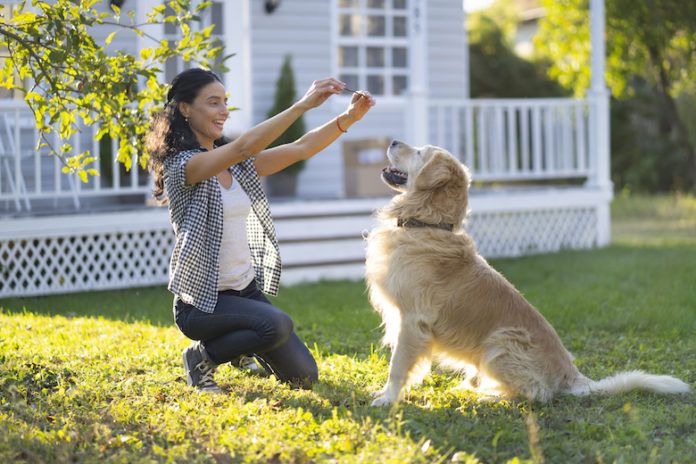Our dogs have very little opportunity for choice in their lives in today’s world. We control what and when they eat, when they play, when and where they can go to the bathroom, and where they sleep. We expect them to walk politely on leash without exploring the rich and fascinating world around them, and want them to lie quietly on the floor for much of the day. Compare this to how dogs used to live: running around the farm, chasing squirrels at will, eating and rolling in deer poop, chewing on sticks, digging in the mud, swimming in the pond, following the tractor…
Noted behaviorist and Utah State University psychology professor Dr. Susan Friedman says, “The power to control one’s own outcomes is essential to behavioral health.”
There’s a good likelihood that our dogs’ lack of choice is at least partly responsible for the amount of stress we are seeing in many of our canine companions these days, and some of the resulting behavior challenges. Imagine how stressed you would be if your life was as tightly controlled as your dog’s!
You can introduce choice to your dogs by teaching a “You Choose” cue:
1. Select a very high-value and very low-value treat.
2. Show high-value treat to your dog and name it: Meat, Beef, Chicken, High, etc. Let him eat it. Repeat several times.
3. Show the low-value treat to your dog and name it: Kibble, Milkbone, Low, etc. Let him eat it. Repeat several times.
4. Now tell him to “Wait,” say your high-value name, put the high-value treat in one bowl and show it to him in one hand, then name your low-value treat, put it in a different bowl, and show it to him in your other hand. Place both bowls on the floor at your feet at the same time, about six inches apart. Repeat “Wait” if needed, to keep him from eating it. (If your dog doesn’t have a good “Wait” behavior, either have someone hold his collar or leash, or teach him to “Wait.”
5. Now say “You choose!” “Pick one!” (or whatever you want your “Choice” cue to be) and invite him to choose a bowl. While he eats that treat, quickly pick up the other bowl so he doesn’t eat that treat also.
6. Repeat numerous times, putting high-value/low-value randomly on alternate sides, until it’s clear he’s realizing he can choose his preference. (You might be surprised to discover what you think is higher value for him – may not be!)
Watch for “side-preference”
If your dog always eats the treat from the bowl on the same side regardless of which treat is in it, your dog has a strong “side preference” – like a left-handed or right-handed person. You can overcome this by putting your high-value treat on his non-preferred side, and his low-value treat on his preferred side far off to the side, and doing lots of repetitions, very gradually bringing the preferred-side treat closer and closer. When he will continue to choose the high-value treat even when the low-value treat is close, go back to switching them randomly.
Generalize “Choice”
Now that your dog understands the concept of choice, you can use it in a variety of situations. Take him in the vicinity of your back door and say, “Want to go out? You Choose!” If he gets happy and moves toward the door he is saying “Yes!” and you can open the door, say “Okay, go!” and let him out (assuming your yard is fenced!). If he looks away, stays calm or otherwise indicates that he’s not excited about the prospect of going out you can say, “Never mind,” and close the door, keeping him in the house with you.
Perhaps you’re going for a walk and the path divides. Stop, have him sit at the fork in the path, say “You choose!” and let him pick which way he wants to go. Offer him two toys and say “You choose!” so he gets to pick which toy he wants to play with. Put some serious thought into other ways to give him choices, and incorporate as many as you can into his world. As Dr. Friedman reminds us, the more he can control his own outcomes, the more behaviorally healthy he is likely to be.
Top photograph: Vladimir Vladimirov/Getty Images
Read Next: Whole Dog Journal, Pro-Choice, November 2016







This was a great article and very informative. Thank you for this.
My 6-month old puppy is struggling to learn rules for living with a toddler, two cats and a bunny. If there is anything she needs more of right now, its the right to choose. Thank you so much for this article!